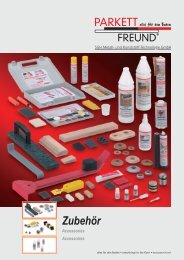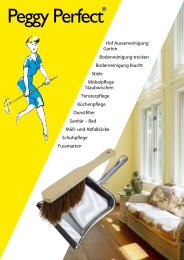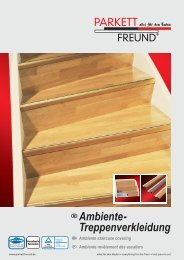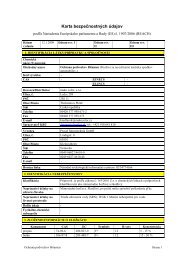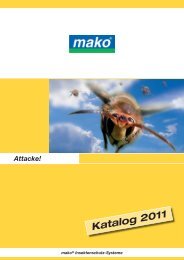Universal Profile Preisliste 2009 - MAKO COLOR sro
Universal Profile Preisliste 2009 - MAKO COLOR sro
Universal Profile Preisliste 2009 - MAKO COLOR sro
Sie wollen auch ein ePaper? Erhöhen Sie die Reichweite Ihrer Titel.
YUMPU macht aus Druck-PDFs automatisch weboptimierte ePaper, die Google liebt.
TK <strong>Universal</strong> <strong>Profile</strong><br />
TK <strong>Universal</strong> profiles / TK Profils universels<br />
Sicherheits-Treppenkantenprofile,<br />
Verlegeanweisung<br />
Safety stair nosings,<br />
Instructions for fastening<br />
Nez de marches de sécurité,<br />
Instructions de pose<br />
Das TK-SYSTEM besteht aus 2 kombinierten Teilen:<br />
1. die Metall-Treppenschienen aus Messing oder Aluminium<br />
2. die PVC-Einlage (dazu passend)<br />
Die Verlegung ist denkbar einfach:<br />
Die Metall-Treppenschienen haben in ihrer Schwalbenschwanzführung (in die später die Einlage kommt) versenkte Bohrlöcher. Man verschraubt<br />
(Stein: verdübelt) die Metall-Treppenschienen auf der Stufe (Verklebung wurde bereits positiv durchgeführt).<br />
Die PVC-Einlage wird im kalten Zustand auf das gewünschte Fixmaß geschnitten.<br />
Durch die neu entwickelte Längsnute (Aussparung) an der Unterseite der Einlage wird es ermöglicht, die PVC-Einlage im temperierten<br />
Zustand (Zimmertemperatur) zusammenzudrücken und sie mühelos – von oben – in die Schwalbenschwanzführung der Metall-<br />
Treppenschiene einzudrücken!<br />
Achtung! Sehr wichtig!<br />
Die PVC-Einlage wird wohl in der Regel im kalten Zustand an die Baustelle gebracht. In diesem Zustand ist die PVC-Einlage naturgemäß<br />
so steif, dass sie kaum zusammengedrückt werden kann. Sehr wichtig ist dann, dass die Einlage auf Zimmertemperatur angewärmt wird.<br />
Dieser Zustand ist erreicht, wenn sich die Einlage mit den Fingern zusammendrücken lässt. Achten Sie aber unbedingt darauf, dass die<br />
Einlage nicht zu stark erhitzt wird, weil sie sich sonst erst ausdehnt und später schrumpft!<br />
Wir empfehlen dringend, die PVC-Einlage – wenigstens an beiden Enden – festzukleben, um eventuellen Schrumpfungen zu begegnen!<br />
The TK-System consists of 2 combined components:<br />
1. the metal - brass or aluminium - stair nosings<br />
2. the PVC-insert (cut to fit)<br />
Fastening is very easy:<br />
The metal stair nosings have countersunk holes in their dovetailing guides (into which the inserts are subsequently fitted). They are<br />
fastened on the step by screwing them (for stone stairs use dowels). (Succesful result also by gluing).<br />
The PVC-insert should be cut to the required fixed size in cold condition.<br />
The two new expansion joints on the back side allow to compress the tempered insert (at room temperature) and to fix it easily overhand<br />
into the dovetailing guide of the metal stair nosing!<br />
Attention! Very important!<br />
The PVC-insert will normally be delivered to the building site in cold condition. Naturally the PVC-insert is so rigid in that condition that<br />
it can hardly be compressed. Then it is very important to heat the insert to room temperature. This condition is obtained when the insert<br />
can be compressed by your fingers. Take care, however, not to heat the insert more than necessary, because otherwise it will tend first to<br />
expand and then to shrink!<br />
We urgently recommend to glue on the PVC-inserts – at least at the two ends – in order to prevent any possible shrinkage!<br />
Le système de nez de marches comprend 2 parties combinées:<br />
1. la barre de seuil pour marches en métal, laiton ou aluminium<br />
2. l’insert en PVC (l’insert adapté)<br />
La pose est facile à réaliser:<br />
Les barres de seuils pour marches sont pourvues d’un percement noyé dans leur guidage de queue d’aronde (dans lequel l’insert sera<br />
introduit ultérieurement). Les barres de seuils sont vissées (si béton: chevillées) sur la marche. (L’encollage a également fait ses preuves.)<br />
L’insert en PVC doit être coupé sur mesure à froid.<br />
Grâce à la rainure longitudinale nouvellement conçue (encoche) il est possible d’insérer le support en PVC à température ambiante en<br />
appuyant bien et de l’introduire facilement - par le haut – dans le guidage de la queue d’aronde de la barre de seuils en métal pour nez<br />
de marches!<br />
Attention! Très important!<br />
En général l’insert en PVC est livré sur le chantier à l’état froid. Dans cet état l’insert est par nature si rigide qu’elle ne peut à peine être<br />
pressé. Il est alors très important de réchauffer l’insert à température ambiante. Vous obtiendrez ce résultat en le pressant entre vos<br />
doigts. Veillez cependant que l’insert ne soit pas trop réchauffé car il risquerait alors de s’étirer et après de se rétracter!<br />
Nous vous recommandons vivement de coller l’insert en PVC – au moins aux deux extrémités – afin d’éviter d’éventuelles rétractions!<br />
70<br />
alles für den Boden • everything for the floor • tout pour le sol



